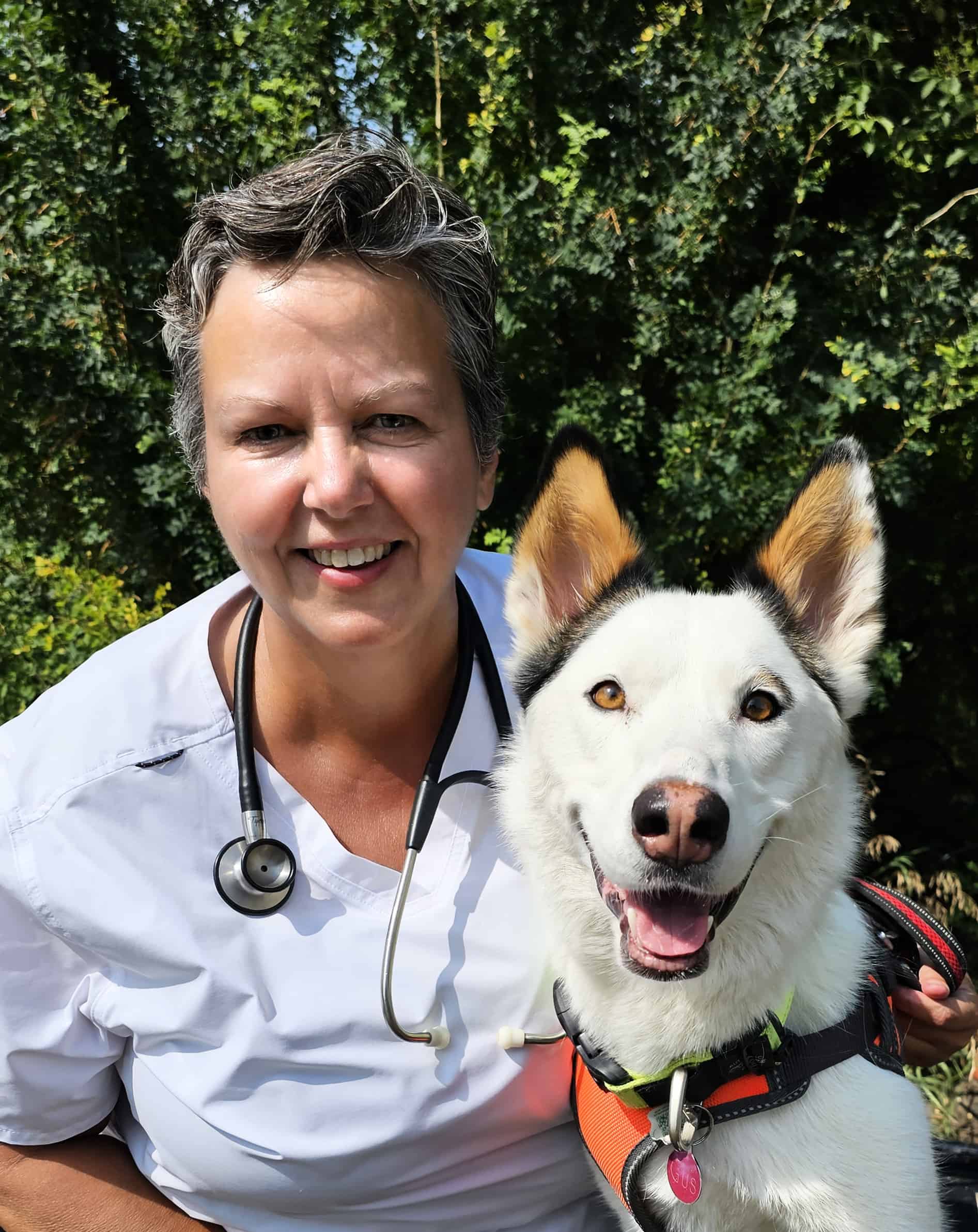Are you considering adding a Ragdoll cat to your family? Whether you’re already a proud owner or considering adoption, it’s important to understand the specific needs of this unique and popular breed.
The Ragdoll cat is a breed that is highly sought after by cat lovers across the world. They are known for their gentle disposition and striking appearance, soft, plush coats, and vivid blue eyes. Ragdolls are very intelligent cats and can easily be taught simple tricks, making them the perfect choice for families with children.
In this article, we will dive into everything you need to know about the breed, including their origin, personality, potential health issues, grooming requirements, dietary needs, and more.
Whether you are an experienced Ragdoll cat owner or considering adding one to your household, this guide will offer valuable insights to ensure that your pet remains happy and healthy throughout its life
Ragdoll Cat Origins
The Ragdoll cat breed originated in California in the 1960s, and their development can be attributed to a woman named Ann Baker.
Ann, a Persian cat breeder, owned a female cat of no particular breeding – a white longhair rescue by the name of Josephine. Ann noticed that the kittens from Josephine had unique traits. These kittens were was very gentle and calm, and had a tendency to go limp and relaxed when picked up, earning them the name “Ragdoll.”
Baker was intrigued by this and began breeding Josephine with other cats, most likely Persian and Birman, to create a new breed. The breeding program continued for several years, and Baker’s goal was to create a cat with a calm and affectionate temperament, as well as a soft and plush coat.
Baker trademarked the name “Ragdoll” in the 1970s and established the International Ragdoll Cat Alliance (IRCA) to oversee the breed’s standards. However, over time, disagreements arose within the organization, and several breeders split off to form their own organizations, leading to variations in the breed’s standards and appearance.
Today, Ragdoll cats are recognized by most major cat registries and are known for their gentle nature, intelligence, and affectionate personality. They are a popular choice for families and are often described as “puppy-like” in their behavior, as they enjoy following their owners around and interacting with them.
Ragdoll Cat Characteristics
Ragdoll Cat Intelligence
Ragdoll cats are known for their intelligence. While intelligence in cats can be difficult to measure, Ragdolls are often described as having a “dog-like” intelligence, meaning they are highly trainable and can learn a wide range of tricks and behaviors.
This breed has a demonstrated ability to learn new behaviors and commands. They are often trained to perform tricks such as playing fetch, responding to their names, and adapt quickly to walking on a leash.
They are always looking for new ways to play and interact with their owners. Their high level of intelligence allows them to understand and follow commands quickly, making them great pets for those who enjoy training and interacting with their pets.
Another sign of their intelligence is their problem-solving skills. Ragdoll cats are known for their curious nature, and they enjoy exploring their environment and finding new ways to interact with their surroundings.
They are skilled at finding solutions to problems, such as opening doors and cabinets. Of course, these skills mean that they are capable of getting into trouble too!
Are Ragdoll Cats Affectionate
One of the characteristics that Ragdoll cats are best known is for their affectionate and friendly nature.
They are often described as being “lap cats” and enjoy cuddling with their owners. Many Ragdolls are also known for following their owners around the house and seeking out attention, making them very social pets.
Ragdoll cats are generally very gentle and relaxed, which makes them great pets for families with children or other pets. They are known for being patient and tolerant of even the most energetic of children, and they often enjoy being held and petted.
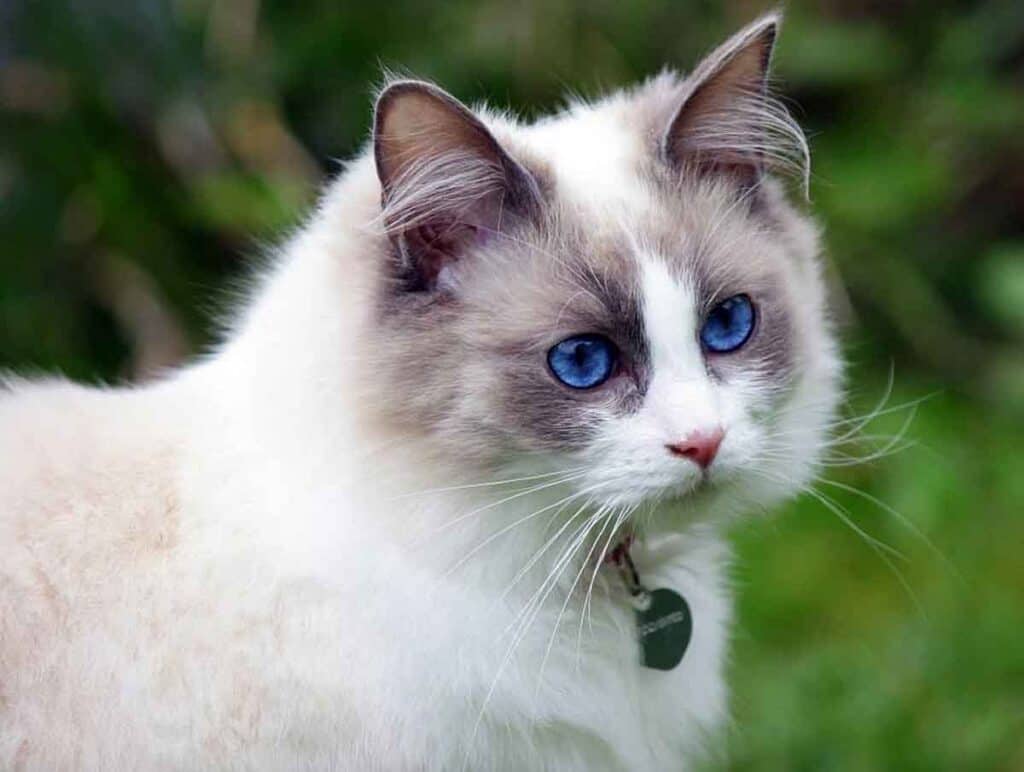
Are Ragdoll Cats Friendly With Other Animals
Ragdoll cats are typically friendly with other animals, including dogs and other cats. They have a gentle and laid-back temperament, which makes them less likely to exhibit aggressive behavior towards other animals.
However, it is important to introduce Ragdoll cats to other animals slowly and carefully to ensure a positive and safe experience for everyone involved. It is best to supervise any interactions between your Ragdoll cat and other pets, particularly during the initial introduction period.
Ragdoll cats may also have different temperaments and personalities, so it is important to consider the individual cat’s behavior and preferences when introducing them to other animals. Some Ragdolls may be more shy or reserved, while others may be more outgoing and playful.
In general, Ragdoll cats are social animals and enjoy the company of other pets. They often thrive in households with multiple pets, particularly if they are introduced at a young age and given plenty of time to socialize and bond with their animal companions.
Ragdoll Cat Personality
Ragdolls have a calm and gentle demeanor that makes them great family pets. They are generally not aggressive and are not prone to destructive or disruptive behaviors.
They are often described as gentle, relaxed, and social animals that enjoy spending time with their owners. However, their curious nature also means that they enjoy exploring their environment, which can lead to some mischief at times!
Are Ragdoll Cats Good With Children
Ragdoll cats tend to be good with children, making them great family pets. They tend to be patient and tolerant of even the most energetic of children.
With their sweet, affectionate nature, these cats love attention and cuddles from their owners, including children. In addition to their gentle and patient nature, Ragdoll cats are also intelligent and trainable, which can make them fun pets for children to interact with.
Ragdoll Cat Vocalization
Ragdoll cats are not known for being very vocal cats, but when they do vocalize, their sounds are often described as soft, low-pitched, and melodious.
One of the most common vocalizations of the Ragdoll cat is the “chirp” or “trill.” This sound is a soft, high-pitched noise that is often used as a greeting or to express happiness. Ragdolls may also make a soft purring sound when they are content and relaxed.
In addition to their chirps and purrs, Ragdoll cats may also meow to communicate with their owners. However, their meows are typically soft and low-pitched, rather than loud and demanding like some other breeds.
While Ragdoll cats are generally not very vocal, they may become more vocal when they want something, such as attention or food. They may also vocalize more during times of stress or anxiety, such as when they are in an unfamiliar environment or are feeling unwell.
Ragdoll Cat Energy Level and Exercise Needs
With their laid-back and relaxed personalities, Ragdolls are not typically very high-energy cats. They tend to be more relaxed and enjoy lounging around the house, which means that they do not require as much exercise as some other cat breeds.
While Ragdolls may be less active than other cats, it is still important to provide them with opportunities for exercise and play to keep them healthy and happy. This can include providing them with toys to play with, such as feather wands or puzzle feeders, or setting aside time each day for interactive playtime.
In addition to playtime, Ragdoll cats can benefit from daily exercise, such as walks on a leash or other light physical activity. This can help prevent obesity and promote overall health and wellbeing.
Are Ragdoll Cats Easy to Train
Ragdoll cats are known to be intelligent and quick learners, and they enjoy spending time with their owners, which can make training a more enjoyable experience for both the cat and the owner.
One of the most common training techniques for Ragdoll cats is positive reinforcement, which involves rewarding good behavior with treats or praise. This can be an effective way to encourage desirable behaviors, such as using a scratching post instead of furniture, or coming when called.
Ragdoll cats can also be trained to perform tricks, such as sitting, rolling over, or jumping through hoops. Training can be a great way to provide mental stimulation and enrichment for your cat, and it can help strengthen the bond between you and your pet.
It is important to note that like all cats, Ragdolls have their own personalities and preferences, and not all cats will be interested in training. Some may be more independent and less interested in following commands, while others may be more eager to please and quick to learn.

Ragdoll Cat Appearance
How Big Do Ragdoll Cats Get
Ragdoll cats are one of the largest breed of cats. It is important to note that the size of a Ragdoll cat can vary depending on a number of factors, including genetics, gender, and nutrition. While some Ragdolls may be smaller or larger than average, most are known for their size and heavy build.
These cats typically reach their full size and weight between 3 to 4 years of age. Adult Ragdoll cats can weigh anywhere from 10 to 20 pounds, with males typically being larger than females. Some individuals have been known to reach 25 pounds!
On average, adult Ragdoll cats can grow to be around 17 to 21 inches in length, from the tip of their nose to the base of their tail. Their tails can add an additional 10 to 12 inches to their overall length, bringing their total length to around 27 to 33 inches.
Ragdoll Cat Coat Type
Their soft and silky coats are one of their most distinctive features of the Ragdoll breed. Ragdoll cats have a semi-longhair coat type, which means that their coats are longer than those of shorthair cats, but not quite as long as those of some other longhair breeds.
According to The Cat Fancier’s Association, the Ragdoll’s fur coat consists primarily of long, soft outer guard hairs. Unlike many long haired breeds, the Ragdoll does not have a dense, insulating undercoat. This makes them less likely to mat, and easier to groom.
Ragdoll Cat Color And Patterns
The Ragdoll cats’ coat patterns appear in four patterns, including bicolor, colorpoint, mitted, and van. Point patterns include solid, lynx, tortie, or torbie, and colors in any pattern include seal, blue, chocolate, lilac, red, and cream.
- Bicolor: This pattern features a white or cream base color with large patches of one of the four main colors. The cat’s face, legs, and tail are typically colored, while the body and underbelly are white or cream.
- Colorpoint: This pattern features a lighter base color with darker points on the cat’s face, ears, tail, and feet. The darker points can be any of the four darker colors, and are typically paired with a lighter underbelly in cream or white.
- Mitted: This pattern features a darker base color with white “mittens” on the cat’s front paws and white boots on the back paws. The cat’s face, ears, and tail are also typically colored.
- Van: The point color is restricted to their ears, tail, and mask. The ear and tail colors are dense and well-defined, while the mask may be limited to the upper part and show a gradual fading of color. The rest of the cat’s body, legs, and feet are white with minor spotting allowed.
Ragdoll Cat Eye Color
Ragdoll cats are known for their stunning blue eyes, which are typically large, round, and expressive. The Cat Fancier’s Association has specified blue eye color as a breed standard. The color can range from a pale sky blue to a deeper sapphire blue.
However, not all Ragdoll cats have blue eyes. Some Ragdoll cats may have eyes in shades of green, gold, or even odd-eyed, which means each eye is a different color.
Like all kittens, Ragdolls are born with blue eyes, and their eye color may change as they age. Some Ragdoll cats may have blue eyes that gradually change to green or gold as they mature, while others may keep their blue eyes throughout their life.
Ragdoll Cat Lifespan
The lifespan of a Ragdoll cat can vary depending on a variety of factors such as genetics, environment, and diet. On average, Ragdoll cats live between 12 to 17 years, with some cats living into their early 20s.
Ragdoll Cat Health Issues
Like all cats, Ragdolls are prone to certain health issues that owners should be aware of. This breed is also known to be at risk for several genetic diseases.
Hypertrophic Cardiomyopathy (HCM)
Hypertrophic cardiomyopathy is a common heart condition that affects cats, and Ragdolls are especially prone to this condition. HCM occurs when the walls of the heart become thickened, making it difficult for the heart to pump blood effectively.
Many cats with HCM never show any signs. Those that are more severely affected may have difficulty breathing, become weak or lethargic, or may even die suddenly. It’s important to note that HCM is not curable, it can be managed with medication and lifestyle changes.
Although genetic testing for HCM is not yet available for other cat breeds, there is fortunately a test for use specifically in Ragdoll cats. Genetic testing is available to detect carriers the genetic mutation that causes the condition. Responsible breeders test their cats before breeding.
Polycystic Kidney Disease (PKD)
Polycystic kidney disease is an inherited condition that causes cysts to develop in the kidneys, which can eventually lead to kidney failure. PKD is most common in Persian cats, but Ragdolls can also be affected.
As the cysts grow, the kidneys become enlarged and start to lose function. Symptoms of PKD do not appear until kidney failure starts to manifest. Clinical presentation of cats with renal failure can include increased thirst and urination, loss of appetite, and weight loss.
During a physical examination, a veterinarian may be able to feel significantly enlarged kidneys. Ultrasound or x-rays may also be used to examine the kidney and look for evidence of cysts. Treatment consists of managing the symptoms and providing supportive care.
Tests are available to detect carriers of the gene that causes PKD. There is currently no cure for PKD, but early detection and management can help prolong your cat’s lifespan and improve their quality of life.
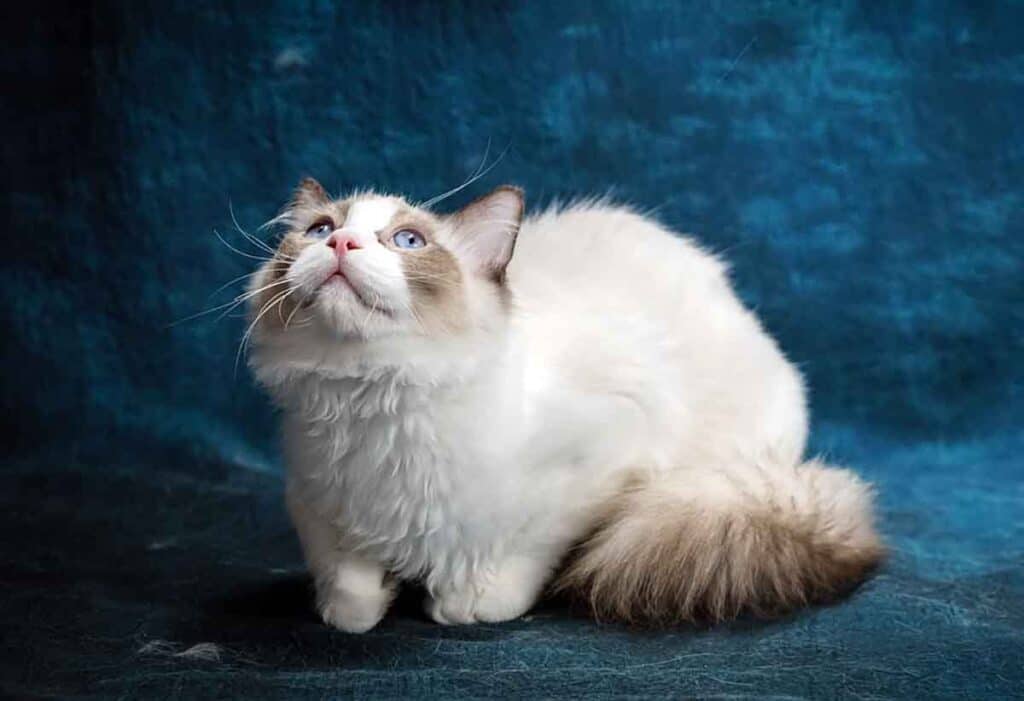
Bladder Stones
Research has shown that Ragdoll cats are also prone to developing bladder stones, which are mineral deposits that form in the bladder. Symptoms of bladder stones can include painful urination, blood in the urine, and frequent urination.
If your Ragdoll has bladder stones, your veterinarian may recommend a special diet to dissolve the stones or surgery to remove them. To prevent bladder stones, it’s important to provide your Ragdoll with plenty of fresh water and a balanced diet that promotes urinary health.
Obesity
Because of their calm and laid-back nature, Ragdoll cats are in general less active than many other breeds. Reduced activity means they are prone to obesity, which can lead to a variety of health problems such as diabetes, heart disease, and joint problems.
Obesity in cats is often caused by overfeeding and a lack of exercise. To prevent obesity in your Ragdoll, it’s important to provide them with a balanced and nutritious diet and plenty of opportunities for exercise and play.
Regular veterinary checkups can also help you monitor your cat’s weight and catch any potential health problems early on.
Dental Problems
Ragdolls can be prone to dental problems such as periodontal disease, which is caused by a buildup of plaque and tartar on the teeth. Symptoms of dental problems can include bad breath, swollen gums, and difficulty eating.
To prevent dental problems in your Ragdoll, make sure to provide them with regular dental care such as brushing their teeth or using dental treats. Your veterinarian can also help you monitor your Ragdoll’s dental health and provide additional treatments if needed.
Ragdoll Cat Care
Ragdoll Cat Grooming
Although they have a relatively low-maintenance coat for a longhaired breed, the Ragdoll’s long hair can still become tangled and matted, leading to skin irritations and other issues. Regular grooming of your Ragdoll cat regularly will help ensure their good health and appearance.
The primary grooming requirement for Ragdoll cats is brushing, and they should be brushed at least once or twice a week. A slicker brush is an excellent tool for removing loose hair and preventing mats. A metal comb is also useful for detangling knots and removing debris.
Ragdoll cats do not require frequent baths, but it is recommended to give them a bath every 2-3 months. Bathing too often can strip the natural oils from their skin and coat, leading to dryness and irritation.
Use a mild shampoo specifically designed for cats to avoid skin irritation. Rinse your cat thoroughly to remove all the shampoo, and then towel dry them. A blow dryer can be used, but be sure to use a low setting to avoid overheating your cat.
As with all cats, trimming your Ragdoll cat’s nails is an essential part of grooming. Overgrown nails can cause discomfort and even lead to health issues. If you hear a clicking sound when your cat walks on a hard surface, it is time for a nail trim.
Use cat nail clippers, and make sure you do not clip too close to the quick, which is the pink part of the nail. If you are unsure or uncomfortable clipping your cat’s nails, a professional groomer or veterinarian can assist you.
Ragdoll Cat Diet And Nutrition
When it comes to feeding your Ragdoll cat, choose a high-quality cat food that meets all of their nutritional needs. Ragdoll cats have a tendency to become overweight, so it is important to keep an eye on their waistline and adjust their diet if they are becoming pudgy.
There are two main types of cat food: wet and dry. Wet cat food typically contains more protein and fewer carbohydrates than dry cat food, making it a good choice for Ragdoll cats. Wet cat food also provides more moisture, which can help prevent urinary tract infections and other health problems.
Dry cat food is convenient and can be left out for your cat to nibble on throughout the day, also known as free-choice feeding. Again, if you find your cat is putting on too much weight, you will need to adjust their diet by either reducing the amount of food they get each day or switching a lower calorie food.
Regardless of whether you choose wet or dry cat food, it is important to read the label carefully. Look for a cat food that contains high-quality protein sources such as chicken, turkey, or fish, and avoid cat foods that contain by-products, fillers, or artificial preservatives.
Also, make sure they always have access to plenty of fresh, clean water. Dehydration can lead to a variety of health problems, especially bladder and kidney stones, so it is important to provide your cat with plenty of water to drink.
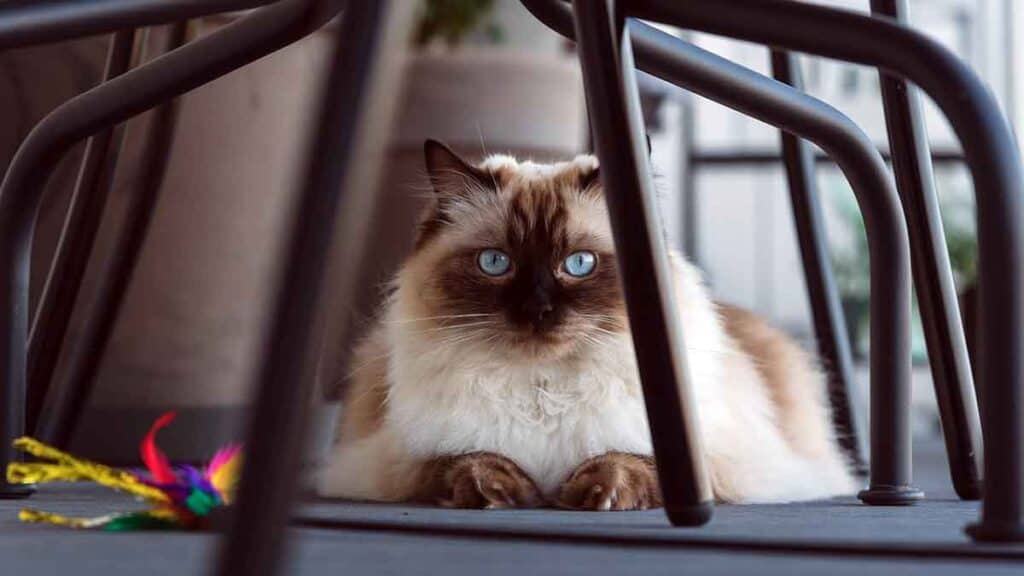
Are Ragdoll Cats Hypoallergenic?
Unfortunately, Ragdoll cats are not hypoallergenic. In fact, no cat breed is truly hypoallergenic.
The allergen that triggers allergic reactions in humans is a protein found in cat saliva, skin, and urine. When cats groom themselves, they deposit this protein onto their fur, and when their fur dries, the protein becomes airborne and can cause allergic reactions in some people. Skin flakes (dander) that are shed by the cat can also cause allergic reactions.
While some people may be less sensitive to certain breeds of cats, including Ragdolls, there is no scientific evidence to suggest that Ragdolls are hypoallergenic.
If you are allergic to cats but are considering getting a Ragdoll, it is important to spend time with a Ragdoll cat before bringing one into your home to see if you experience any allergic reactions.
Where To Buy Ragdoll Cats
If you are interested in purchasing a Ragdoll cat, there are a few different options available to you. Here are some places where you might be able to buy a Ragdoll cat:
Reputable Breeders
One of the best ways to get a Ragdoll cat is to purchase one from a reputable breeder. Reputable breeders will ensure that their cats are healthy, socialized, and have a good temperament. They will also be knowledgeable about the breed and can answer any questions you may have.
When looking for a breeder, be sure to do your research and ask for references or recommendations from other cat owners.
Here is a link to a breeder list to get you started: https://tica.org/ragdoll-breeders
You can also find breeders with kittens for sale in your area by going to Petfinder.com and enter your location.
Pet Stores
Some pet stores may carry Ragdoll cats, but it is important to be cautious when purchasing from a pet store. Not all pet stores source their cats from reputable breeders, and you may end up with a cat that has health issues or behavioral problems.
In fact, most cat breed associations and registries require their members to abide by a code of ethics that prohibits selling cats to pet stores for resale. Consequently, the probability is high that a Ragdoll kitten found at a pet store originated from “kitten mill” or similar questionable source.
Be sure to ask questions about where the cat came from, and if possible, visit the cat’s breeder before making a purchase.
Adoption
You can also adopt a Ragdoll cat from a shelter or rescue organization. While Ragdoll cats are a popular breed, they do sometimes end up in shelters or rescues due to various reasons such as their owners being unable to care for them or the cat becoming lost.
Adopting a cat can be a great way to give a loving home to a cat in need. Shelters and rescues often mandate that the cats be spayed or neutered before they are adopted, so you can be sure they won’t add to the pet population.
Adopting a Ragdoll cat is also less expensive than purchasing one from a breeder. We always advocate for adopting a rescued cat whenever possible.
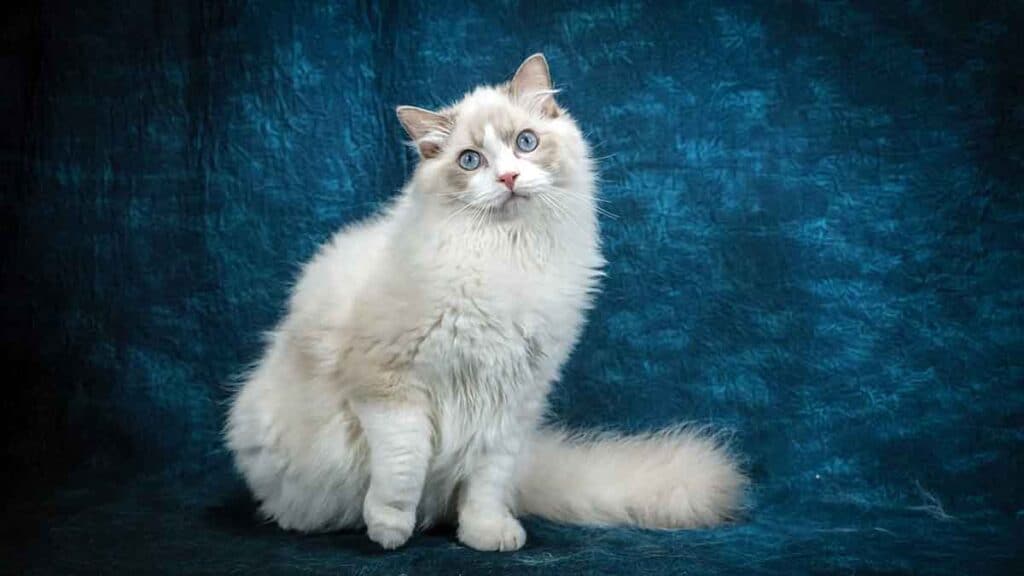
Ragdoll Cat Price
On average, a Ragdoll kitten from a reputable breeder costs between $1200 and $2500. However, some breeders may charge more for kittens from champion bloodlines or for rare coat colors or patterns. Also, the price of Ragdoll cats can vary greatly depending on several factors such as location, breeder, bloodline, and age.
You may be able to find a non-registered kitten for sale for less, but these are usually unplanned matings or cats of otherwise questionable breeding and unknown health status. The term “you get what you pay for” usually applies when the price is cheap.
While purchasing a Ragdoll cat from a reputable breeder may come with a higher price tag, it can also provide the buyer with assurance of the cat’s health and quality. Buying from a breeder who does not prioritize the cat’s health and well-being can result in higher veterinary costs down the road.
Additionally, the cost of owning a Ragdoll cat goes beyond the initial purchase price. Potential owners should also factor in the cost of vaccinations, spaying or neutering, grooming, food, and toys. These ongoing expenses can add up quickly over the cat’s lifetime.
Adopting a Ragdoll cat from a shelter or rescue organization is usually a more affordable option, if you are able to find one there. The cost of adoption fees and any initial veterinary care will typically be lower than purchasing a kitten from a breeder.
Conclusion – The Nitty Gritty About This Kitty
At Cat BYTES, we believe Ragdoll cats are a wonderful addition to any home. With their affectionate and docile personalities, they make great companions for individuals or families of all ages.
We hope this article has been helpful in giving you an overview of the breed characteristics, as well as tips on how to find and care for your own Ragdoll cat.
If you have additional questions about these beautiful felines, please don’t hesitate to reach out! Our team is always here to help answer any queries that may come up during your search for the perfect kitty companion.



